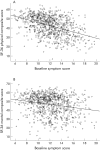Functional dyspepsia, delayed gastric emptying, and impaired quality of life
- PMID: 16322108
- PMCID: PMC1856317
- DOI: 10.1136/gut.2005.078634
Functional dyspepsia, delayed gastric emptying, and impaired quality of life
Abstract
Background: It remains controversial as to whether delayed gastric emptying in functional dyspepsia is associated with a specific symptom pattern, and it is unknown if gastric emptying in functional dyspepsia is a driver of impaired health related quality of life (HRQOL). We aimed to evaluate the relationship between functional dyspepsia symptoms, gastric emptying, and HRQOL.
Methods: US patients (n=864; mean age 44 years (range 18-82); 74% female) with functional dyspepsia, as defined by Rome II criteria, were enrolled into one of four clinical trials. All patients had a baseline scintigraphic assessment of gastric emptying of an egg substitute meal, and the trials were stratified on this assessment. Delayed gastric emptying was defined as having at least 6.3% residual volume at four hours. A total of 290 (34%) patients had delayed gastric emptying. HRQOL was assessed by the SF 36 and Nepean dyspepsia index (NDI).
Results: Postprandial fullness was independently associated with delayed gastric emptying but the association was weak (odds ratio (OR) 1.98 (95% confidence interval (CI) 1.02, 3.86); p=0.04). No independent association was seen with epigastric pain, early satiety, nausea, or bloating. Mean SF 36 physical composite score (PCS) was 42.3 (95% CI 41.6, 43.0) and the mean SF 36 mental composite score (MCS) was 46.8 (95% CI 46.0, 47.5); both mean scores were significantly lower than age and sex adjusted national norms of 50 (p<.0001). Female sex, increasing age, and higher symptom scores for fullness, epigastric pain, and nausea were each independently associated with decreased PCS scores (all p<0.05). Higher baseline nausea symptom score, lower gastric emptying rates at one hour, and lower body mass index were associated with decreased MCS (all p<0.05). Female sex, epigastric pain, and nausea, but not gastric emptying, were associated with an impaired score on the NDI. However, the magnitude of the significant associations were all small.
Conclusions: In patients with functional dyspepsia selected for a clinical trial programme, gastric emptying did not usefully stratify them symptomatically. Quality of life of patients with functional dyspepsia enrolled in this clinical trial programme was significantly impaired but this was not explained by delayed gastric emptying.
Comment in
-
Does delayed gastric emptying really cause symptoms in functional dyspepsia?Gut. 2006 Jul;55(7):909-10. doi: 10.1136/gut.2005.086355. Gut. 2006. PMID: 16766745 Free PMC article.
References
-
- Camilleri M, Brown M L, Malagelada J R. Relationship between impaired gastric emptying and abnormal gastrointestinal motility. Gastroenterology 19869194–99. - PubMed
Publication types
MeSH terms
LinkOut - more resources
Full Text Sources
Medical



